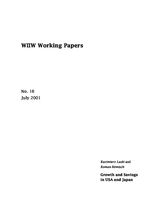Growth and Savings in USA and Japan
In a simplified model GDP growth depends on the demand effect of private investment growth and on the growth of the private savings ratio. In a generalized model private investment (IP) has to be supplemented by the trade balance (E) and the budget deficit (D), their sum being termed NPCE (Non-Private-Consumption-Expenditures). Hence GDP growth depends, in the generalized case, on the demand effect of NPCE growth and on changes in the private savings ratio. In the present paper the term NPCE (given the import and tax coefficients) is treated as independent of GDP, hence exogenous in the model. In contrast, the private savings ratio does depend on GDP, especially on the distribution of disposable GDP between undistributed profits of firms and private households, as well as the latter's propensity to save.
Using this model the relation between growth and private savings in the USA and in Japan between 1960 and 2000 is investigated in the paper. The results of the analysis of the period 1996-2000 are of special interest. In the USA a sharp decline of the private savings ratio helped to achieve a high rate of GDP growth at a stagnating NPCE term. In Japan an increase in the private savings ratio provoked an almost stagnating GDP although the NPCE term increased rather substantially. These results prove that spendthrift in the USA (especially of the private households) turned out to be a collective blessing while thrift in Japan has become a collective fault.
The causes of the different developments of the private savings ratio in the USA and Japan require further research. We have found that in the USA the private savings ratio depends not only on income of but also on wealth, defined as equity shares at market value, owned by private households.
Keywords: growth, savings, private investment, trade balance, budget deficit, propensity to save of private households, USA, Japan
JEL classification: B22, E12, E20, H62
Countries covered: Japan, USA
Research Areas: Macroeconomic Analysis and Policy
